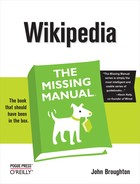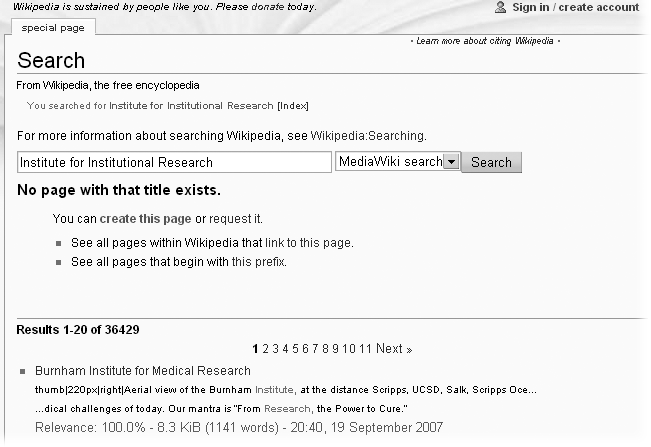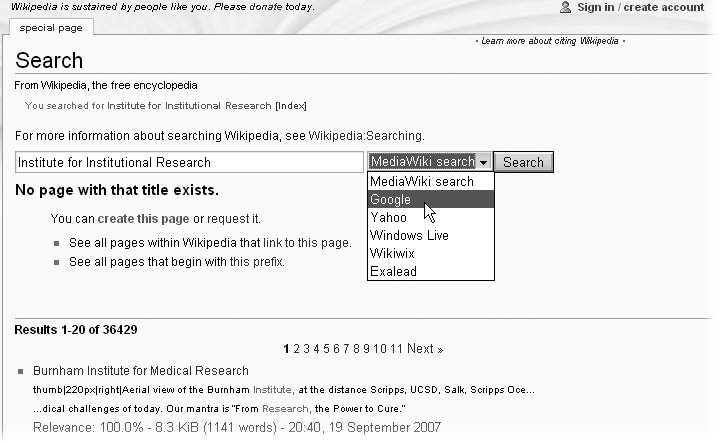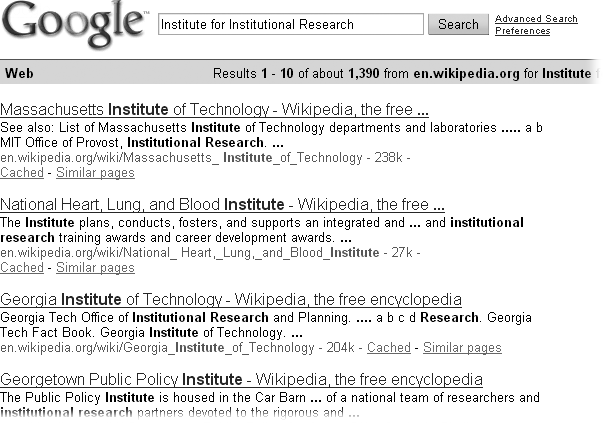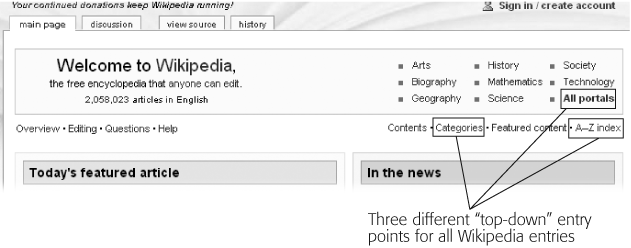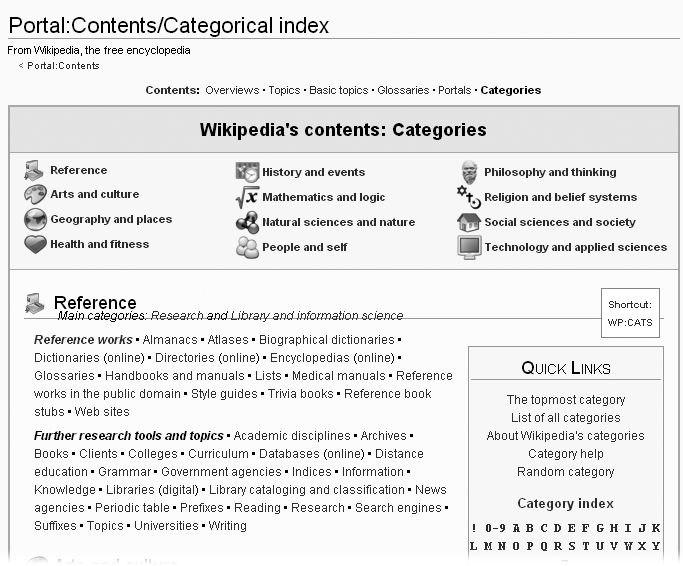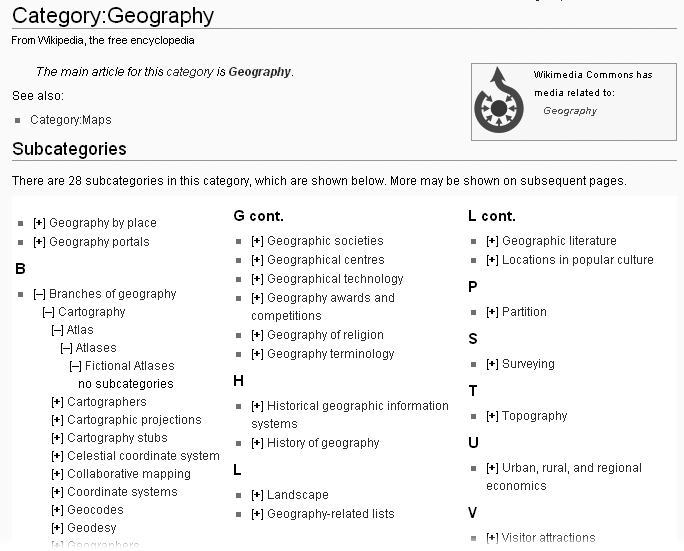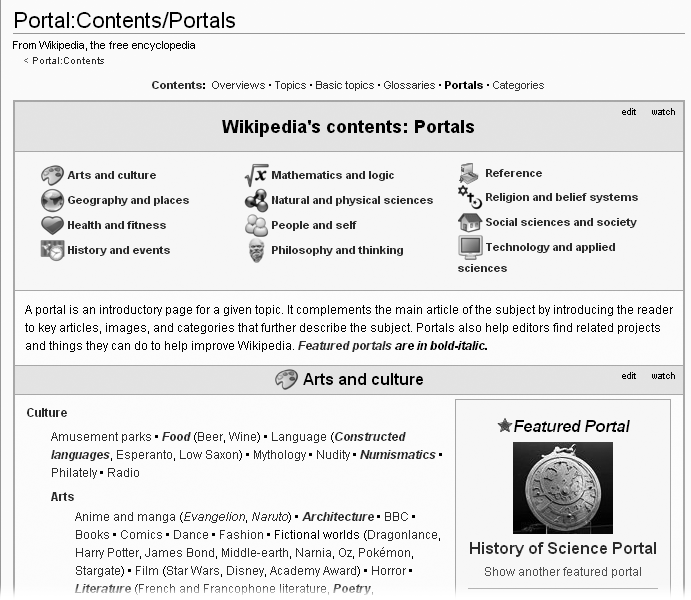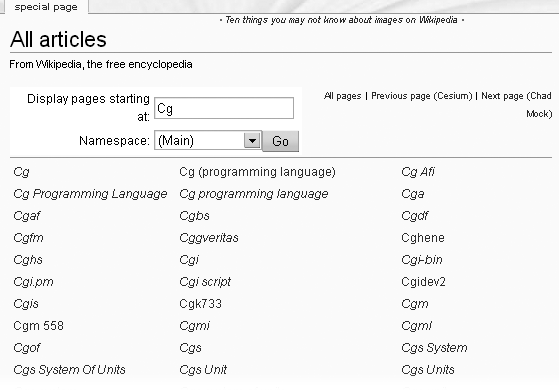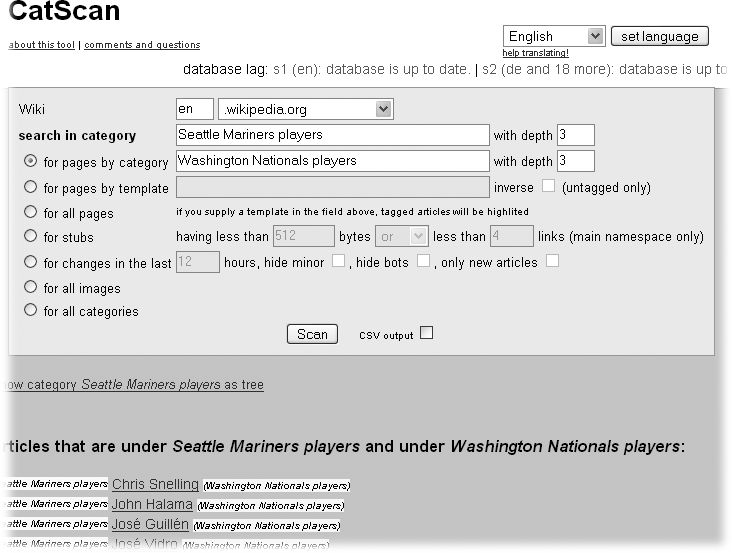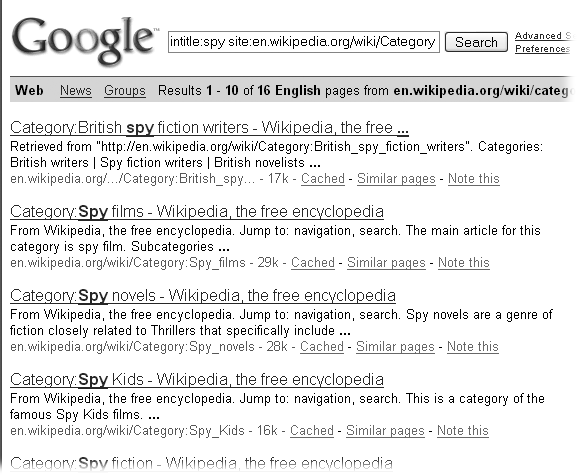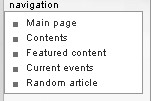There are two basic ways to find interesting articles in Wikipedia: Do a search, or browse, starting from the Main Page. Wikipedia has lots of organizing features depending on how you want to browse, like overviews, portals, lists, indexes, and categories. But for a bit of amusement, you can also try a couple of unusual ways to go from article to article, as discussed in this section.
On the left side of each Wikipedia page, you’ll find a box labeled “search”, with two buttons—Go and Search. Wikipedia’s search engine is widely acknowledged to be not particularly good. Your best bet to find what you want is to type the title you’re looking for into the search box, and then click Go (or press Enter). If you’re right, and Wikipedia finds an exact match, you’ll be at that article. If it doesn’t find an exact match, Wikipedia provides you with a link to “create this page”, which you should ignore if you’re searching only for reading purposes. It also provides you some search results. Figure B-3 shows the result of a failed search for the title Institute of Institutional Research, including the start of some best guess results).
Note
If you click “Search”, for curiosity’s sake, you’ll just get some so-so search results. For example, if you search for Reagan wife, the article Nancy Reagan shows up 6th and Jane Wyman shows up 16th. Worse, the context Wikipedia’s result page shows is terrible. With a Google search, by contrast, you can get these two names from the context shown for the first result without even having to click a link.
Figure B-3. When Wikipedia can’t find an exact match to a Go request, it provides search results. (If you are a registered editor, and logged in, the search result page will look like Figure 13-2.)
If you don’t arrive at an article page when you click Go, and you don’t find what you’re looking for in the search results toward the bottom of the page, your next best move is to switch to another search engine. Wikipedia makes this very easy for you—just change “MediaWiki search” to another menu choice, as shown in Figure B-4.
Figure B-4. Wikipedia makes it easy to pick another search engine. Here Google’s being selected, but other search engines are available. Take advantage of this option if your initial Go attempt doesn’t succeed.
Figure B-5 shows the search done again using Google. To those familiar with the Wikipedia search engine, it’s not surprising that the top results are completely different.
You can also navigate Wikipedia via a number of different starting points. The best way to get to them is via the links near the top of the Main Page, as shown in Figure B-6. Every Wikipedia page has a link to the Main Page, on the left side, in the navigation box below the Wikipedia globe. From the Main Page, you can see the vastness of Wikipedia via three different approaches: categories, portals, and the A-Z index.
Figure B-6. Wikipedia’s Main Page is accessible via a single click from any other page in Wikipedia. At the top are three links to starting points within Wikipedia that provide different top-down views.
Any article may belong to one or more categories (Chapter 17), which you’ll find listed at the bottom of the article. Like everything else in an article, editors add the categories, so categories are only as accurate as the people who enter them; like everything else, if someone sees a mistake, she can fix it. When you click the Categories link shown in Figure B-6, you’ll see the master index (see Figure B-7).
Figure B-7. Here’s the top-level list of categories. It’s the starting point for drilling down to find all articles in any particular subcategory.
The text in Figure B-7 is hand-crafted, not computer-generated, but once you leave the page via a link on it, the lists you’ll see will be computer-generated and thus completely current. For example, when you click Geography and places, at the top, that takes you to a section of the page called “Geography and places”, with the main category Geography. Click that word, and you’ll see Figure B-8. If you’re interested in Geography, you can drill down in whatever subcategory you want until you reach actual links to articles, and then follow them.
Figure B-8. The category Geography had 28 subcategories when this screenshot was taken. In the “B” section, you see an expansion of one of those subcategories, Branches of Geography, displaying all the sub-subcategories until there are no further ones, along one line of that subcategory.
Note
Not every article in Wikipedia is intricately categorized. For example, at the bottom of the Category:Geography page, you see articles in that category which are not in any subcategory (you can’t see them in Figure B-8). Those may be truly unique articles, or articles just waiting for further categorization work.
From the Main Page, you can also follow the bolded link “All portals” to the main page for portals (Figure B-9). Like categories, portals can be a great way to narrow down the number of articles you’re particularly interested in reading, or to lead you to articles that you otherwise might never have known existed.
The third entry point link on the Main Page is the A-Z index. It’s equivalent to browsing the shelves of a library, with the books in alphabetical order on the shelves. Figure B-10 shows what you’ll see if you click the “A-Z index” link at the top of the Main Page.
Figure B-10. The A-Z index (also called the Quick Index) lets you go directly to a list of articles beginning with any two characters: El or Na or Tr or whatever.
If you were trying, for example, to find the name of an article that began with an unusual pair of letters (say, Cg), then the A-Z index may be helpful (see Figure B-11).
Figure B-11. If you pick a two-letter starting pair, in Figure B-10, and click that link, here’s what you see. The links in regular text are articles; the links in italics (the majority) are redirects, which take you to an article with a different name. Redirects are used for misspellings, for less common variants of a particular name, and for subjects that don’t (yet) have their own articles, and are related to an existing article to which the reader will be directed.
The alphabetical index to articles is actually more useful after you’ve drilled down one level. Now you have the option of searching for articles that start with three or four or even more characters.
You may have noticed, in Figure B-7 and Figure B-9, a top-level row of links: Contents, Overviews, Academia, Topics, Basic Topics, and so on. Three of these (Overviews, Topics, Basic Topics) are also high-level entry points into Wikipedia that you might want to check out to see if one or more are interesting.
You can view Wikipedia's entire hierarchy of categories by clicking the Categories link near the top of the Main Page, as shown in Figure B-7. But you can also use the category system to browse Wikipedia in a number of other ways, using tools both inside and outside of Wikipedia. For example, there are links at the bottom of each article that let you find articles in related categories. You can also find articles that fall into two different categories. You can even narrow your search by category when you're using an external search engine.
At the bottom of virtually every article, you'll find the categories that Wikipedia editors have assigned to that article. Figure B-12 shows an example.
Figure B-12. The article on major league baseball player Lee Smith has, at the bottom, a larger than usual number of categories. In this case, it's mostly because Smith was a member of eight different teams.
Click any of these categories, and you'll be on a category page similar to Figure B-8. With a click, you can jump to another article in the same category.
One of Wikipedia's most requested features is "category intersection"—the ability to get a list of all articles that fall into two or more categories. While Wikipedia now has that ability, it’s not as good as what you can find at an off-Wikipedia page called CatScan at http://toolserver.org/~daniel/WikiSense/CategoryIntersect.php. Figure B-13 shows how to use it to find, for example, baseball players that have been members of both the Seattle Mariners and the Washington Nationals.
Figure B-13. When you search for articles by category using CatScan, you can choose how many levels of sub- and sub-sub-categories you want to search. This search shows a depth of 3, but since there were no subcategories, the results are only for a depth of 1. But if you were using the category Architects, you'd see results in subcategories such as American Architects (level 2) and Architects from Cincinnati (level 3).
Warning
When using CatScan, capitalization—except for the very first letter—is critical. For example, in Figure B-13, if you had search on the category "Seattle Mariners Players" instead of "Seattle Mariners players," you'd have gotten no matches.
External search engines are generally better than Wikipedia's search feature, as discussed on Searching Wikipedia. When you use an external search engine, you simply restrain your search results to Wikipedia pages and apply any other options you like. If you use Google, for example, you can search just Wikipedia category pages by typing site:en.wikipedia.org/wiki/Category in the search box. Figure B-14 shows an example of using this domain restriction in Google.
Figure B-14. This Google search restricts results to category pages, since "site:en.wikipedia.org/wiki/Category" was typed into the search box. It furthermore requires that the title of the category page contain the word "spy"; note "intitle:spy" at the beginning of the search term. There are 16 categories with "spy" in the title. Searching for "spy" instead of "intitle:spy" would turn up category pages with "spy" anywhere on the page (of which there are about 500).
Tip
You can also use the technique shown in Figure B-14—finding category pages of interest—before you use the category intersection tool CatScan, to avoid having to guess the exact names of categories that you want to use in CatScan.
When you’re not on the Main Page, every Wikipedia page offers ways of browsing around. Most of them are in the list of links at the left.
If you want to get a sense of the more than two million articles in the English language, a good way is to use the Random article feature. On any page on the http://en.wikipedia.org Web site, you find this link at upper-left (Figure B-15) that you can click to ask the Wikipedia software to select one of those two million articles for you.
When you’re on an article page, you may find that another link on the left side of the screen, the first in the box labeled toolbox (see Figure B-16) can also be fun to play with. Click What links here, and you’re now looking at a list of incoming links to the article you were just reading.
Figure B-16. The toolbox on the left of the screen includes a “What links here” link. Click it to see all the Wikipedia pages that link into the page you’re on.
The list of links may seem random, but it’s not—the oldest page (based on when the page was created) is listed first, the youngest page is listed last (and may very well not show on the screen, which normally lists just 50).
It can also be fun to just follow links from one article to another: For example, start at Kevin Bacon, then to Circle in the Square Theatre, to Theodore Mann, to Drama Desk Award, to New York Post, and end up at Alexander Hamilton. You can also do the same with the “What links here” links mentioned in the previous section.
